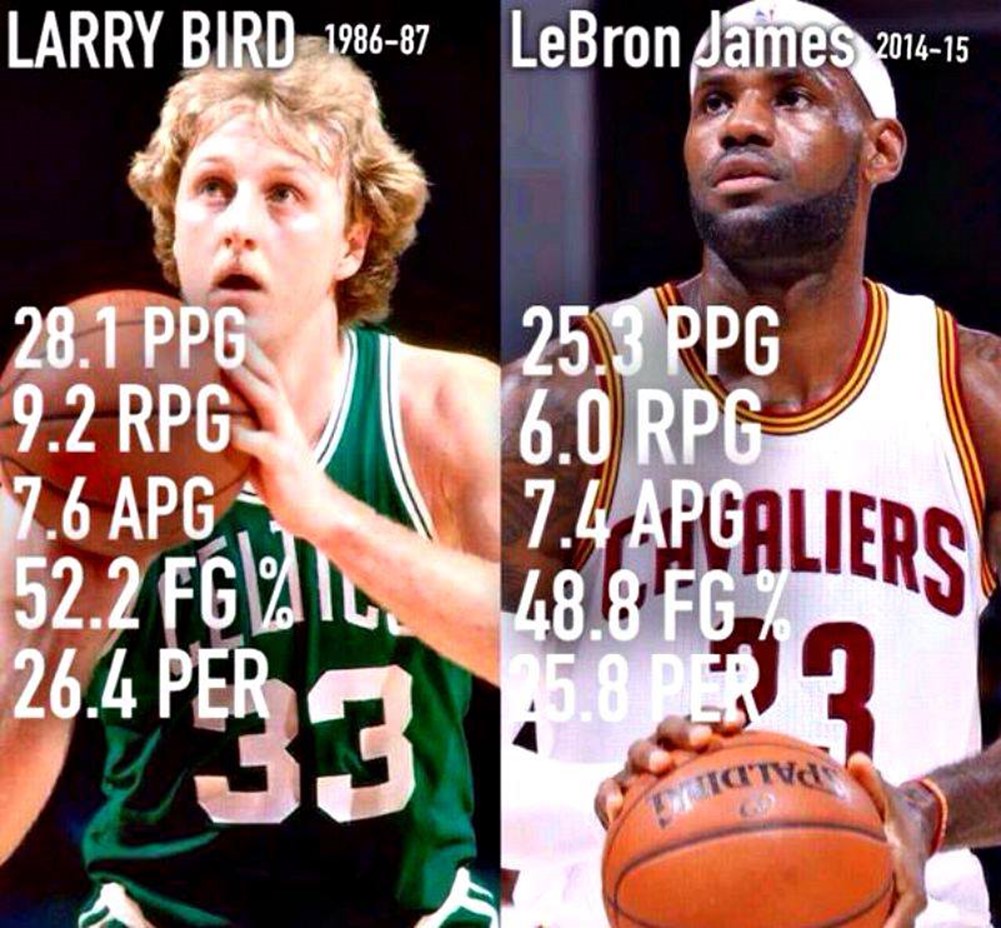
So there I was on Facebook, minding my own everyone else’s business when I came across a post from a friend of mine. The post was the picture above with the headline “Larry Bird vs. Lebron James at 30”.
Now anyone who knows me, knows that I am a huge LeBron James fan. On and off the court, this is a man I am happy my kids see as a role model. However, for every super fan cheering successes of their superstar there is a super hater on the other side cheering for their failures. It is just the human condition… I guess.
While the fans gloss over every negative misstep made by their stars, the haters seem to gloss over any positive qualities as to not weaken their antipathy. Both sides engage in more emotionally than intellectually fueled arguments. Acquiring perspectives drawn from information analyzed by the emotional part of their brains. Resulting in positive or negative charged emotions for the object of their affection/aversion. Whether it’s sports, politics, religion, or one’s favorite character on ‘Downton Abbey’ the same dichotomy applies. And, not unlike this picture posted above, you will find that parties of either camp will use real facts, used out of context, to “prove” their point. But facts that are used out of context, aren’t facts at all. They are just fictional truths. So upon seeing this post, I thought it would be a great illustration of how people and/or institutions use non-contextual truth to influence others to accept ill-conceived, subjective conclusions as their own.
I know that some of you could care less about basketball and others of you may be in the LeBron hater camp, but I implore you to put aside your own subjectivity and preconceived notions. Just evaluate this as nothing more than a sports analogy used to exemplify a common tactic used by those seeking to control us.
We are first going to take a deeper look into the picture above, revealing the OP’s thinly veiled agenda. Next, I will illustrate how, by broadening the scope of information, we can reveal truths that would otherwise remain concealed. Finally, I’ll discuss the tactics commonly used to influence us, the implications of these influences, and how we can be cognizant and selective of what we accept as truth. So without further ado, let’s talk sports!
At first glance at the graphic above, one would have to concede that Larry Bird had better statistics during the 1986-87 season than LeBron did in the 2014-15 season. Based on that information how could you not? And if that was the objective of this post, I wouldn’t have an issue. But, that is not the objective of this post. Clearly when comparing the two players at a specific age, the original poster (OP) was trying to make comparisons of the players themselves not their statistics. In doing so, the OP had isolated the facts from these two individual seasons to influence the reader to conclude that a 30 year old Larry Bird was a better player than a 30 year old LeBron James. This reasoning, though flawed, is still somewhat sound.
However, the argument wasn’t posed as an argument at all. It was disguised as a simple analysis of the statistics of each player at 30 years old, leaving the reader to draw their own conclusions of who the better player was. This is where the tomfoolery of the OP comes into play. When you offer your readers only a limited scope of information on which they are to draw their conclusions, then their conclusions can only be drawn based on that information. In this case that conclusion would have to be, since Bird leads every statistical category, that Bird is the better player. Makes sense right? Well maybe, but before we make up our mind I would like to investigate the context of these stats by slowly broadening the scope of information through the 4 examples I have laid out below.
(NOTE FOR SPORTS FANS : While I will discuss rebounds briefly, this is one of two stats that Bird was consistently better than LeBron. The other was free-throws. For their careers they both averaged 49.6 field goal percentage)
Example #1
The 1986-87 season was Larry Bird’s 8th season in the NBA and his 8th season with the Boston Celtics. Statistically speaking, let’s look at how each of these stat categories rank compared to other seasons in his career:
Points: 28.1 (3rd highest season average for his career. 1st highest was 29.9 in ’87/88 and 2nd was 28.7 in ’84/85; Averaged 26 points or more in 3 seasons)
Rebounds: 9.2 (3rd lowest of career; Career average 10; Career high 10.9)
Assists: 7.6 (Career high; Averaged 7+ assists in 3 seasons)
FG%: 52.5% (2nd highest of career; Career high is 52.7%; averaged 50% or more 5 times in his career.)
PER (Player Efficiency Rating): 26.4 (3rd highest of career; 1st was 27.8 in ’87/88 and 2nd was 26.5 in ’84/85; Had a season average PER of 25 or more in 4 seasons of career)
The 2014-15 season was LeBron’s 12th season in the NBA and his 1st season back with the Cleveland Cavaliers after spending 4 seasons with the Miami Heat. Now, let’s look at how each of these stat categories rank compared to other seasons in his career:
Points: 25.3 (2nd lowest season average for his career. 1st lowest was 20.9 during his rookie year in ’03/04; Averaged 26 points or more in 10 seasons)
Rebounds: 6 (2nd lowest of career; Career averaged 7.1; Career high 8)
Assists: 7.4 (2nd highest of Career; Averaged 7+ assists in 7 seasons; Career high 8.6)
FG%: 48.8% (5th lowest of career; averaged 50% or more 5 times in his career; Career high 56.7%)
PER (Player Efficiency Rating): 25.9 (4th lowest of career; Career high 31.6; Had a season average PER of 25 or more in 10 seasons of career)
As we look at the stats above, in context with how these apply in the overall picture, one can see how skewed the numbers look. By looking only at these two individual seasons when each player was 30 years old, without context to how those numbers compare to their overall career, the resulting conclusion would be ignorant of key facts. When you expand the scope of information and you can see that the OP compared the points per game statistic of one of Bird’s best seasons to one of LeBron’s worst, you will start to see things differently. You will see that you will have to analyze some numbers that are fare to the both of them. That being said let’s now take their best overall statistical seasons and compare them to one another:
Example #2
| Name; Age; Season | Larry Bird; 31 years old; 1987-88 Season | LeBron James; 28 years old; 2012-13 |
| Points | 29.9 | 26.8 |
| Rebounds | 9.3 | 8 |
| Assists | 6.1 | 7.3 |
| Field Goal % | 52.7% | 56.5% |
| Player Efficiency Rating (PER) | 27.8 | 31.6 |
Things are now starting to look a little different. In my opinion, in comparing these two seasons, LeBron had the better season. Though I wouldn’t say that the argument couldn’t be made that Bird had an equally good, if not better season. I do believe this is a much more fair comparison, but it is still limited in the information it provides as it looks at only one season out of their whole career. Let us now compare their career high stats in each category from any season:
Example #3
| Name; Number of Seasons Played | Larry Bird; 13 Seasons | LeBron James; 12 Seasons |
| Points (Season) | 29.9 (1987/88) | 31.4 (2005/06) |
| Rebounds (Season) | 10.9 (1980/81,1981/82) | 8 (2012/13) |
| Assists (Season) | 7.6 (1986/87) | 8.6 (2009/10) |
| Field Goal % (Season) | 52.7% (1987/88) | 56.7% (2013/14) |
| Player Efficiency Rating (PER) (Season) | 27.8 (1987/88) | 31.7 (2008/09) |
You should now start to see how the more information you are provided, the more the picture starts to change. Where one could look at Example #2 and make a sound argument for either side, it would be hard to argue for Bird in the example above if these stats were for one season. Since these just represent career highs from any season, the argument still could go either way. However, in this last example we will compare their career averages, as well as their career accomplishments:
Example #4
| Name; Number of Seasons Played | Larry Bird; 13 Seasons | LeBron James; 12 Seasons |
| Points (Career) | 24.3 | 27.3 |
| Rebounds (Career) | 10 | 7.1 |
| Assists (Career) | 6.3 | 6.9 |
| Field Goal % (Career) | 49.6% | 49.6% |
| Player Efficiency Rating (PER) (Career) | 23.5 | 27.7 |
| Regular Season MVPs | 3 | 4 |
| All Star | 12 | 11 |
| All Star MVPs | 1 | 2 |
| Championship Rings | 3 | 2 |
| Finals MVPs | 2 | 2 |
I could have started with this table alone to make a convincing argument that LeBron is better than Bird was, but I wanted to illustrate a point. The point being that as we are provided with more information (perspectives) our perception broadens. Our perception is like our windshield and the broader our windshield, the more we can see. If our access to information is intentionally limited, it is usually limited to drive us to reach conclusions that are preconceived by those who have limited our access to that information.
While at the end of the day, this sports argument will be mainly based on our emotional connections as fans to the stars we cheer for. And that is just fine by me. I would just like us to make sure that when we are given information to base our opinions on, that we are sure to validate that information within its context. This will enable us to make informed decisions based on complete information, not just fictional truths. I used this example on a silly sports argument, but the applications of this epidemic dig deep into our lives. We are bombarded every day with these perspectives given to us by our friends on social networks, our politicians, and especially the media. We are lead to accept perspectives based on limited information, fictional truths, and even blatant lies. We are lead to reach the conclusions they want us to and, consequently, act in a manner conducive to meeting their objectives . This is what they call the Kool-Aid, my friends. And you know who drinks the Kool Aid??? Sheep. The sheep drink the Kool Aid. Abre los ojos. Don’t. Be. Sheep. Baaaah!
Thanks for hanging in there with me. Until next time….
Be Well,


